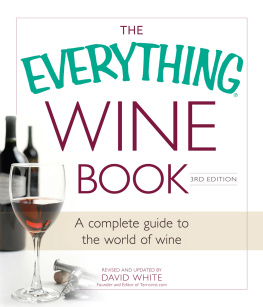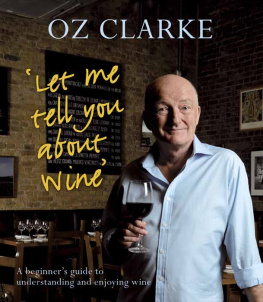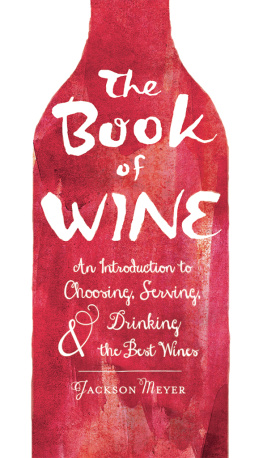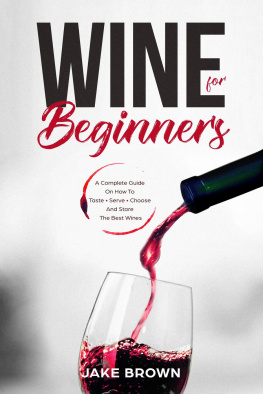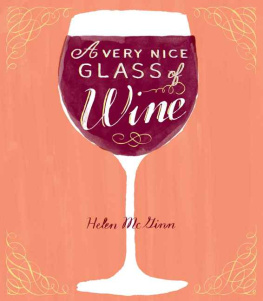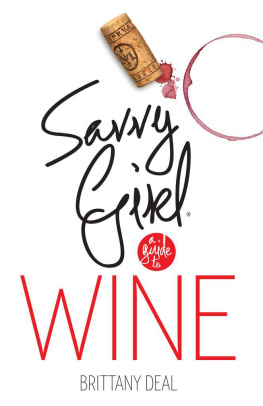THE

WINE BOOK
3RD EDITION
A complete guide to the world of wine
Revised and Updated by David White
Founder and Editor of Terroirist.com

Avon, Massachusetts
This book is dedicated to Zachary and Colin. While theyre too young to drink wine, they arent too young to learn about it!
Contents
The Top Ten Wine Myths
- Aged wine is better than young wine.
Not all wines need aging. Generally speaking, red winesparticularly those high in tanninsrequire more aging than whites. - Red wine should never be chilled.
All wine benefits from chilling. To serve a red wine at its optimal temperature, pop it in the fridge for 25 minutes. - Reserve wines are top of the line.
Reserve on American wine labels has no legal meaning. Winemakers can use the term at their whim. - Wines with sulfites will give you a headache.
Sulfites are the cause of headaches in only about 1 percent of the populationmostly asthmatics. - All German wines are sweet.
German wines come in all degrees of sweetnessfrom dry to very, very sweet. - Screw tops are a sign of cheap wine.
Au contraire! Increasingly, top winemakers are using screw tops to avoid cork contamination of their wines. If a wine is designed for quick consumption, screw caps make more sense. - Wines should always breathe.
In general, breathing is only necessary for wines that need further aging. - All wines have the same amount of alcohol.
The level of alcohol depends on the amount of sugar that has been converted during fermentation. - The more a wine costs, the better it is.
Price is related to many factors: the cost of the vineyard land, the type of grapes used, whether its aged in oak barrels, the reputation of the winery or winemaker, andmost of allmarket demand. - Zinfandel is a pink wine.
Zinfandel is a red grape, but it can be made into a red wine or a ros.
Introduction
PLATO, THE FAMOUS GREEK philosopher and mathematician, spoke wisely when discussing the merits of wine: Nothing more excellent or valuable than wine was ever granted by the Gods to man. Indeed, even the ancients cherished and appreciated wine, just as wine aficionados treasure the spirit today.
But if you are a newcomer to the world of wine, you may wonder what connects you to an ancient philosopher, or even some of the most educated wine experts around the globe. The answer is simple: Everyone can sip, savor, and enjoy wine. And you dont have to be an expert to discover subtle nuances of flavor, select the perfect bottle to pair with your meal, or choose a varietal to suit your mood. If you find wine to be a bit intimidating at this point, then try not to think of it as an interest or a subject to be mastered. Think of wine as a living, breathing, and dynamic beverage that brings people together. The more you experience and share, the more you will learnand have fun!
If you are a newcomer to the world of wine, or even just a casual enthusiast, The EverythingWine Book, 3rd Edition is for you. If your number one fear in life is ordering a bottle of wine at a restaurant, this book will help you breathe easier. If you wish you could give words to the aromas you experience in your favorite Rioja, this book will give you those tools. If you are not really sure what Rioja means, read on.
If you enjoy the game of wine and wish to expand your knowledge of this fascinating drink, this book includes information on wine from all over the world. If youd like to join the expanding online wine community, this book is a great jumping-off point. If you are seriously considering a career in the wine industry or want to make wine at home, again, you have come to the right place.
The great thing about wine is that the more you learn and taste, the more you want to learn and taste. Given the ever-changing, ever-growing world of wine, there is always a new glass to discover.
CHAPTER 1
A Brief History of Wine
The discovery of wine was probably an accident. It didnt have to be invented, because wine can happen all by itself. Its safe to assume that, way back, people learned to store their fruits of summer for the bleak winters ahead. More than likely, they put their grapes into a hollow in a rock, where nature took over, and fermentation turned the grapes into a bubbling liquid, which we now call wine.
Wine in the Ancient World
We may not know how humans were first introduced to wine, but we do know that people have been imbibing since at least 4000 B.C. , perhaps as far back as 6000 B.C. , and maybe even further back than that. Mesopotamia (Persia), near present-day Iran and Egyptthe endpoints of the Fertile Crescentseems to be the birthplace of ancient winemaking, and recent discoveries point to winemaking in China during the same period.
A Persian fable has it that an ancient king kept his beloved grapes in an earthen jar labeled poison. A discontented member of his harem drank juice from the jar in a suicide attempt, but instead of dying, she found her spirits quite rejuvenated. She shared the drink with her king, who took her into his favor and decreed that, henceforth, grapes would be allowed to ferment.
Ancient Persia was truly wine country. Not only did the Persians give toasts to their gods with wine, they also paid salaries in wine. Men earned ten to twenty quarts a month, and women earned ten. The grape varieties they used to make wine are believed to be the precursors of those used today.
The ancient Egyptians cultivated grapes and made wine in a surprisingly modern fashion. They developed the first arbors and pruning methods, and their grapes were stomped and fermented in large wooden vats. The wine was mostly sweet white wine, probably made from the grape now known as the Muscat of Alexandria. As a matter of respect to the gods, the Egyptians used wine in their funeral rites. Depending on the status held by the deceased, his body and belongings were anointed with wine prior to being entombed.

Most of the Muscat of Alexandria cultivated today ends up as table grapes or raisins. But you can find modern wines using the grape in Spains Moscatel de Mlaga, which is heavy, sweet, and golden brown, or in Portugals Moscatel de Setbal, which is a sweet fortified wine.
Situated between Egypt and Mesopotamia along the Fertile Crescent were the Phoenicians, who sailed the Mediterranean from what is now the coast of Lebanon. Thus the grapevineand winefound its way to Greece, Sicily, and north-central Italy.
During ancient times, everyone drank wine and beer, even children. Thats not as decadent as it might sound. Frankly, drinking the water was hazardous to ones health, and wine was a good substitute thirst quencher. If you sipped one of those old-style wines today, you would probably notice that it tastes more like vinegar with a hint of cider, and possesses a fairly low alcohol content. It was certainly better than the water that was available. While wine was a staple of daily life, it was consumed mostly by the rich and powerful. Beer was the drink of the common folk.

